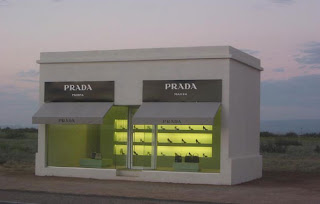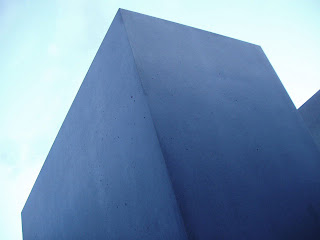I've been waiting for the fence to come down and the new
Contemporary Jewish Museum to open. The blue cube has been peaking over the fence for months, winking.
The blue cube is the Yud portion of the extension, designed by Daniel Libeskind, enlarging the original 1907 brick power substation refurbished as museum. Another portion, the Chet, runs down the middle. Together,
yud and
chet spell
L'Chaim, to life. New life from old energy (building).
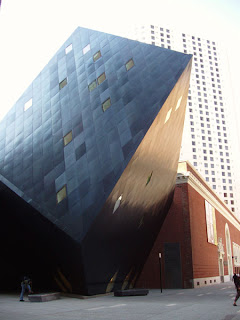
The blue cube is set akimbo to the rectilinear factory building, jumping out of it like alive with energy.
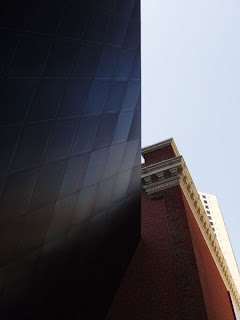
The blue cube is 3000 blue steel panels, shade-shifting, glimmering and set with 36 diamond windows.
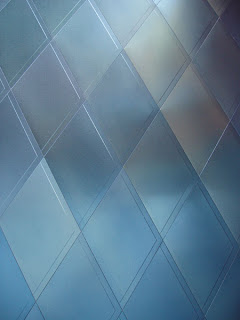
Wow. Wowwowwow, what a beautiful building.

Inside too.
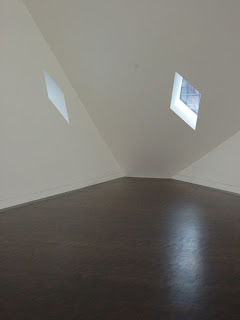
The Yud room, center of the cube, is spacious, spacey. Presently it houses a sound installation: music by various artists commissioned by John Zorn to compose works inspired by letters of the Hebrew alphabet. The work by Erik Friedlander was playing; Lou Reed came next.
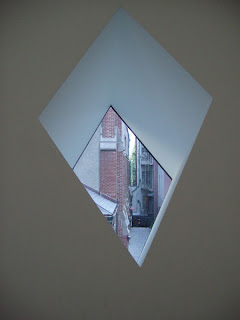
Inside and out, the building, the works, the whole shebang reflects back on a heritage, ancient and multivalent.
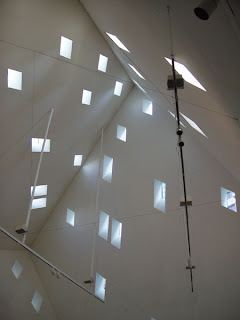
It's not what I expected. I don't know what I expected. The shards of light gather here. No secular museum space this: spirituality worn on the sleeve, woven throughout.
The inaugural exhibition is
In The Beginning: Artists Respond to Genesis. The show includes a wide range—newly commissioned works, installations, illustrations, and an exquisite illuminated Haggadah from the 14th century. The biblical presence was strong here, as everything dealt in some way with "In the beginning..." In case you've forgotten, it goes like this:
In the beginning when God created the heavens and the earth, the earth was a formless void and darkness covered the face of the deep, while a wind from God swept over the face of the waters. Then God said, "Let there be light"; and there was light. And God saw that the light was good; and God separated the light from darkness. God called the light Day, and the darkness he called Night. And there was evening and there was morning, the first day.
My money's on Matthew Ritchie for Best in Show. His installation was one of the works commissioned for this exhibit. It is multilayered, so bear with me as I try to capture it. Across two walls is a squiggly black line drawing (magic marker) with six empty centers. Colored animations are projected onto these spaces to the accompaniment of various overlapping audio tracks, music and spoken voice. The animations depict swirling universes, formless and forming, tumbleweed worlds, fire balls, storms and clouds of birds, surging oceans, molecules, under sea whorls: universes all, great and small. From where I sat, the violin was more prominent than the texts piped from other speakers, but I caught these words: "unrest, confusion, misery." Then there was, "reversal, defeat, failure." That wasn't the whole of it, but that was the message in that moment of unfolding. The worlds turning, tumbling, transforming were mesmerizing what with the hypnotic music and stories heard but not heard. A great experiential depiction of the notion that there are universes within and beyond this universe which we barely know the top or bottom of.
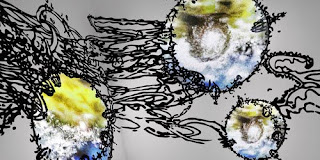
Another commissioned work I really liked was a wall painting by Kay Rosen. Her response to the creation of the world is Do Not Disturb (with the hidden refrain, It Is So.)
The words are painted on one side of the wall, like this:
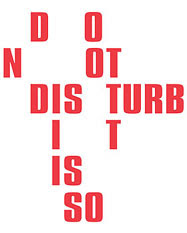
Like any good scriptural mystery, on the other side of the wall, are the reverse of the letters, revealing shadow numbers, 0, 1, 2 stacked in columns of three. Their sum is the title of the work: 063 signifying the Void, 0; the Perfect Work, 6; the Work by half, the imperfect world we inhabit, 3. Perhaps, she suggests, if we humans could refrain from meddling, the world could revert to its original (natural) perfection.
Perhaps. It's also possible that perfection wasn't in the original design. Perhaps that hermetic, sealed and still perfection isn't what creation is about, but it is more like Ritchie's worlds within worlds, always changing, unfolding, unstable, tenuous. The shake-up always right around the corner. The big bang.
The sound of which (the Big Bang) was a part of Ben Rubin's wonderful stainless steel sound sculpture. Modeled on the Horn Antenna built by Bell Labs in 1959, the piece also recalled the logo of the Gramophone Company... His Master's Voice.
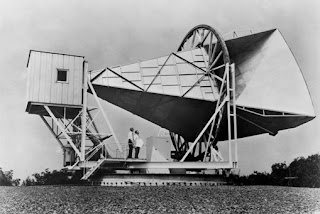
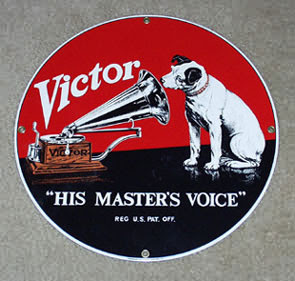
Sounds picked up by the antenna were identified by scientists Arno Penzias and Robert Wilson in 1965 as background radiation, the remnant sounds still floating around space, of the explosion that was The Big Bang Beginning. Recordings of these sounds emanate from the sculpture, and right there, in the museum, you're hearing echos of creation. Awe-some.
If the Horn Antenna is like a giant earpiece, then a telescope is a giant eyepiece seeing deeply into the vast distances of the space that holds the mysterious sounds of the universe. Space also holds man-made mysteries and Trevor Paglen has been tracking them.
Paglen is a geographer-artist who hit my radar when he exposed the flight patterns to and from CIA secret prisons overseas. His work, photographs mostly, centers on the black world, the hidden network of clandestine governmental operations. At the Berkeley Art Museum he's showing new work tracing secret reconnaissance satellites.
The Other Night Sky is an installation that projects on a large-scale globe an animation of the 189 satellites currently orbiting the earth.
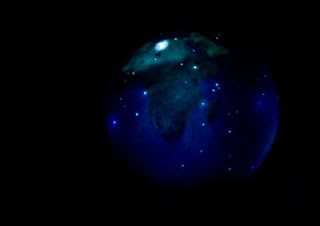
Reconnaissance technologies today can locate individuals anywhere on the ground, record conversations, monitor and photograph activities everywhere and anywhere—defying borders and freely crossing the lines between public and private, legal and illegal. In his photographs, faint lines in the clouds, or between stars, are faint evidence: satellite trails, but the vast amount of information gathered by them is kept secret in the nearly impenetrable black world.
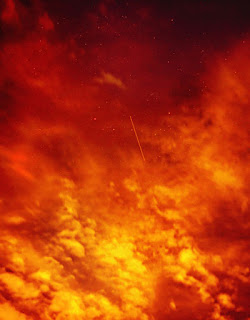
Science opened up the heavens. Galileo's telescope reframed how we understood the galaxy and our place in it. This revelation was the eventual undoing of scriptural authority, but that took some time—first Galileo was imprisoned. Paglen's photographs point to a networked authority wielding secret knowledge in a political inquisition. The parallels with the 16th century are uncanny. The issues of power, truth, secrecy recycle and the answers seem to still be in the stars, in the books, in the images.
Back at the CJM, there was a Barnett Newman painting,
Onement II. It doesn't translate well as a picture, but trust me, it is beautiful, still, deep. Originally called
Atonement in reference to
Yom Kippur, Newman later changed the name of the series to Onement. Asking and receiving forgiveness for sins is the theme of
Yom Kippur. Newman saw that his centered, balanced, still paintings weren't about getting right with god, but about being one with, being one, being whole. These are the ultimate global paintings, one without the other, without distinction, one, before the division of day and night, light and dark. From one all things are possible. Before one is a mystery. After one is possibility. But one. It's the place to be.
 Onement
Onement takes the cake.
CJM exhibition photos courtesy of the museum; building photos are mine.
Paglen pics from
Paglen.comHorn Antenna from
Wikipedia.com



































